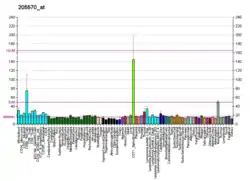PIP4K2A
Phosphatidylinositol-5-phosphate 4-kinase type-2 alpha is an enzyme that in humans is encoded by the PIP4K2A gene.[5][6][7]
| PIP4K2A | |||||||||||||||||||||||||||||||||||||||||||||||||||
|---|---|---|---|---|---|---|---|---|---|---|---|---|---|---|---|---|---|---|---|---|---|---|---|---|---|---|---|---|---|---|---|---|---|---|---|---|---|---|---|---|---|---|---|---|---|---|---|---|---|---|---|
| |||||||||||||||||||||||||||||||||||||||||||||||||||
| Identifiers | |||||||||||||||||||||||||||||||||||||||||||||||||||
| Aliases | PIP4K2A, PI5P4KA, PIP5K2A, PIP5KII-alpha, PIP5KIIA, PIPK, phosphatidylinositol-5-phosphate 4-kinase type 2 alpha | ||||||||||||||||||||||||||||||||||||||||||||||||||
| External IDs | OMIM: 603140 MGI: 1298206 HomoloGene: 37995 GeneCards: PIP4K2A | ||||||||||||||||||||||||||||||||||||||||||||||||||
| |||||||||||||||||||||||||||||||||||||||||||||||||||
| |||||||||||||||||||||||||||||||||||||||||||||||||||
| |||||||||||||||||||||||||||||||||||||||||||||||||||
| |||||||||||||||||||||||||||||||||||||||||||||||||||
| Wikidata | |||||||||||||||||||||||||||||||||||||||||||||||||||
| |||||||||||||||||||||||||||||||||||||||||||||||||||
Function
Phosphatidylinositol-4,5-bisphosphate, the precursor to second messengers of the phosphoinositide signal transduction pathways, is thought to be involved in the regulation of secretion, cell proliferation, differentiation, and motility. The protein encoded by this gene is one of a family of enzymes capable of catalyzing the phosphorylation of phosphatidylinositol-4-phosphate on the fifth hydroxyl of the myo-inositol ring to form phosphatidylinositol-4,5-bisphosphate.
The amino acid sequence of this enzyme does not show homology to other kinases, but the recombinant protein does exhibit kinase activity. This gene is a member of the phosphatidylinositol-4-phosphate 5-kinase family.[7]
Clinical significance
Through genome wide association studies (GWAS), some of the single nucleotide polymorphisms (SNPs) located in this gene have been noticed to be significantly associated with susceptibility of childhood acute lymphoblastic leukaemia in ethnically diverse populations.[8][9]
PIP4K2A Inhibitors
THZ-P1-2[10] (covalent inhibitor) as well as BAY-091 and BAY-297[11] (reversible inhibitors) have been reported as potent and selective PIP4K2A inhibitors. BAY-091 fulfills the quality criteria for a 'Donated Chemical Probe' as defined by the Structural Genomics Consortium.[12]
References
- GRCh38: Ensembl release 89: ENSG00000150867 - Ensembl, May 2017
- GRCm38: Ensembl release 89: ENSMUSG00000026737 - Ensembl, May 2017
- "Human PubMed Reference:". National Center for Biotechnology Information, U.S. National Library of Medicine.
- "Mouse PubMed Reference:". National Center for Biotechnology Information, U.S. National Library of Medicine.
- Boronenkov IV, Anderson RA (February 1995). "The sequence of phosphatidylinositol-4-phosphate 5-kinase defines a novel family of lipid kinases". The Journal of Biological Chemistry. 270 (7): 2881–4. doi:10.1074/jbc.270.7.2881. PMID 7852364.
- Rameh LE, Tolias KF, Duckworth BC, Cantley LC (November 1997). "A new pathway for synthesis of phosphatidylinositol-4,5-bisphosphate". Nature. 390 (6656): 192–6. Bibcode:1997Natur.390..192R. doi:10.1038/36621. PMID 9367159. S2CID 4403301.
- "Entrez Gene: PIP5K2A phosphatidylinositol-4-phosphate 5-kinase, type II, alpha".
- Xu H, Yang W, Perez-Andreu V, Devidas M, Fan Y, Cheng C, et al. (May 2013). "Novel susceptibility variants at 10p12.31-12.2 for childhood acute lymphoblastic leukemia in ethnically diverse populations". Journal of the National Cancer Institute. 105 (10): 733–42. doi:10.1093/jnci/djt042. PMC 3691938. PMID 23512250.
- Liao F, Yin D, Zhang Y, Hou Q, Zheng Z, Yang L, Shu Y, Xu H, Li Y (May 2016). "Association Between PIP4K2A Polymorphisms and Acute Lymphoblastic Leukemia Susceptibility". Medicine. 95 (18): e3542. doi:10.1097/MD.0000000000003542. PMC 4863780. PMID 27149463.
- "Targeting the PI5P4K Lipid Kinase Family in Cancer Using Covalent Inhibitors". Cell Chemical Biology.
- "Discovery and Characterization of the Potent and Highly Selective 1,7-Naphthyridine-Based Inhibitors BAY-091 and BAY-297 of the Kinase PIP4K2A". Journal of Medicinal Chemistry.
- "Donated Chemical Probes". Retrieved July 31, 2023.
Further reading
- Loijens JC, Boronenkov IV, Parker GJ, Anderson RA (1996). "The phosphatidylinositol 4-phosphate 5-kinase family". Advances in Enzyme Regulation. 36: 115–40. doi:10.1016/0065-2571(95)00005-4. PMID 8869744.
- Niiro H, Clark EA (November 2003). "Branches of the B cell antigen receptor pathway are directed by protein conduits Bam32 and Carma1". Immunity. 19 (5): 637–40. doi:10.1016/S1074-7613(03)00303-0. PMID 14614850.
- Carpenter CL (April 2004). "Btk-dependent regulation of phosphoinositide synthesis". Biochemical Society Transactions. 32 (Pt 2): 326–9. doi:10.1042/BST0320326. PMID 15046600.
- Tolias KF, Cantley LC, Carpenter CL (July 1995). "Rho family GTPases bind to phosphoinositide kinases". The Journal of Biological Chemistry. 270 (30): 17656–9. doi:10.1074/jbc.270.30.17656. PMID 7629060.
- Divecha N, Truong O, Hsuan JJ, Hinchliffe KA, Irvine RF (August 1995). "The cloning and sequence of the C isoform of PtdIns4P 5-kinase". The Biochemical Journal. 309 (3): 715–9. doi:10.1042/bj3090715. PMC 1135690. PMID 7639683.
- Rozenvayn N, Flaumenhaft R (March 2003). "Protein kinase C mediates translocation of type II phosphatidylinositol 5-phosphate 4-kinase required for platelet alpha-granule secretion". The Journal of Biological Chemistry. 278 (10): 8126–34. doi:10.1074/jbc.M206493200. PMID 12509423.
- Saito K, Tolias KF, Saci A, Koon HB, Humphries LA, Scharenberg A, Rawlings DJ, Kinet JP, Carpenter CL (November 2003). "BTK regulates PtdIns-4,5-P2 synthesis: importance for calcium signaling and PI3K activity". Immunity. 19 (5): 669–78. doi:10.1016/S1074-7613(03)00297-8. PMID 14614854.
- Schwab SG, Knapp M, Sklar P, Eckstein GN, Sewekow C, Borrmann-Hassenbach M, Albus M, Becker T, Hallmayer JF, Lerer B, Maier W, Wildenauer DB (September 2006). "Evidence for association of DNA sequence variants in the phosphatidylinositol-4-phosphate 5-kinase IIalpha gene (PIP5K2A) with schizophrenia". Molecular Psychiatry. 11 (9): 837–46. doi:10.1038/sj.mp.4001864. PMID 16801950.
- Bakker SC, Hoogendoorn ML, Hendriks J, Verzijlbergen K, Caron S, Verduijn W, Selten JP, Pearson PL, Kahn RS, Sinke RJ (March 2007). "The PIP5K2A and RGS4 genes are differentially associated with deficit and non-deficit schizophrenia". Genes, Brain and Behavior. 6 (2): 113–9. doi:10.1111/j.1601-183X.2006.00234.x. PMID 17410640. S2CID 32120485.
- He Z, Li Z, Shi Y, Tang W, Huang K, Ma G, Zhou J, Meng J, Li H, Feng G, He L (August 2007). "The PIP5K2A gene and schizophrenia in the Chinese population--a case-control study". Schizophrenia Research. 94 (1–3): 359–65. doi:10.1016/j.schres.2007.04.013. PMID 17555944. S2CID 34716299.





